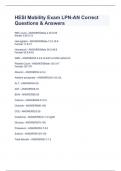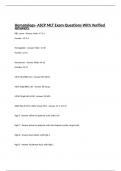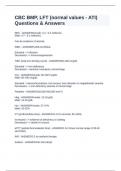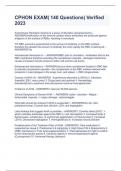Rbc stuvia - Study guides, Class notes & Summaries
Looking for the best study guides, study notes and summaries about Rbc stuvia? On this page you'll find 34 study documents about Rbc stuvia.
Page 4 out of 34 results
Sort by

-
HESI Mobility Exam LPN-AN Correct Questions & Answers
- Exam (elaborations) • 2 pages • 2023
-
Available in package deal
-
- $7.99
- + learn more
RBC count - ANSWERSMale 4.35-5.65 female 3.92-5.13 Hemoglobin - ANSWERSMale 13.2-16.6 Female 11.6-15 Hematocrit - ANSWERSMale 38.3-48.6 Female 35.5-44.9 WBC - ANSWERS3.4-9.6 (3,400 to 9,600 cells/mcl) Platelet Count - ANSWERSMale 135-317 Female 157-371 Albumin - ANSWERS3.4-5.4 Alkaline phosphate - ANSWERS20-130 U/L

-
Hematology- ASCP MLT Exam Questions With Verified Answers
- Exam (elaborations) • 2 pages • 2023
-
- $9.49
- + learn more
RBC count - Answer Male: 4.7-6.1 Female: 4.2-5.4 Hemoglobin - Answer Male: 14-18 Female: 12-16 Hematocrit - Answer Males 44-52 Females 39-47 MCV (HCt/RBC) x10 - Answer 80-100 fL MCH (Hgb/RBC) x10 - Answer 28-32 pg

-
CBC BMP, LFT (normal values - ATI) Questions & Answers
- Exam (elaborations) • 2 pages • 2024
-
- $11.49
- + learn more
RBC - ANSWERFemale: 4.2 - 5.4 million/uL Male: 4.7 - 6.1 million/uL Can be evidence of anemia WBC - ANSWER5,000-10,000/uL Elevated --> infection Decreased --> immunosuppression TIBC (total iron binding count) - ANSWER250-460 mcg/dL Elevated --> iron deficiency Decreased -->anemia, hemolysis, hemorrhage Iron - ANSWERFemale: 60-160 mcg/dL Male: 80-180 mcg/dL Elevated -->hemochromatosis, iron excess, liver disorder or megaloblastic anemia Decreased --> ir...

-
CPHON EXAM| 140 Questions| Verified 2023
- Exam (elaborations) • 11 pages • 2023
-
- $10.99
- + learn more
Autoimmune Hemolytic Anemia is a group of disorders characterized by - ANSWERSmalfunction of the immune system where antibodies are produced against antigens on the surface of RBSs, resulting in hemolysis T/F RBC survival is proportional to the amount of antibody on the RBC surface; therefore the greater the amount of antibody the more rapidly the RBC is destroyed. - ANSWERSTrue Intravascular Hemolysis is - - ANSWERSRBC lysis in circulation - Antibodies bind to the RBC membrane therefore a...

How did he do that? By selling his study resources on Stuvia. Try it yourself! Discover all about earning on Stuvia


